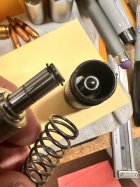Actually this thread holds a lot of similar answers.
I've loaded lots of 223 using FMJ Boat tail bullets and wanted to try hornady V-Max tipped 55gr which is flat bottom and am having an issue... I checked the shell casing in gauges prior and they were fine... Upon loading the bullet, after rechecking the load in the gauge, the cartridge does...
forum.accurateshooter.com
A regular press teaches bad habits, you really can’t develop a good feel of the ballet moving with an 18” cheater bar and compound leverage pivot points. It’s had to explain, because it’s almost a feeling not a fact. Move to an arbor press and you realize how much leverage a standard press has.
The Redding competition die is in the same category. It doesn’t matter how hard you pull the handle, the spring will only push the bullet so hard. If you bottom the spring out so it works like a regular seating die, it’s easy to deform the seating stem. That’s a good thing to check for since it will cause the type of problem you are describing. The end of the stem flares then drags inside the die, or can crack.
Compressed loads are off the table for the same reason. A little bit of compression is not a problem, but the instructions say “no compressed loads” for a reason. If the pour of the powder is not consistent, the seated depth won’t be either. The spring just doesn’t have enough power to compress the powder.
The spring is also sensitive to neck tension. So overly sized necks or inconsistently sized necks will vary the force needed to seat the bullet and vary the length.
You mentioned new brass, and did not mention any lube for the neck or bullet. Here is another place dry neck lube or carbon from previous shooting comes into play. It makes a huge difference in seating force and consistency
A consistent pressure on the lever on the seating stroke is also important, again the spring is in control of how the bullet seats, so how it’s compressed comes into play. Stopping and starting the stroke or variations in speed can cause variations in seated depth.
Setting up the die can be a pain. Seat the bullet, check the length. If it’s not right, set it aside, make your adjustment, pick up another case and bullet and try again. Use the micrometers reading to dial in, it works. The problem is that it takes more force to get a bullet moving once it’s been seated, than one already moving. Working a bullet down to a desired depth in multiple steps is a sure way to have the next bullet seated completely differently, generally shorter.
Sorting your bullets by length and measuring base to ogive might explain some variation, but more than .010” sounds like a brass prep issue more than a bullet variation problem.
I’m sure I missed some other things that play into the mix, but those are the big ones.











